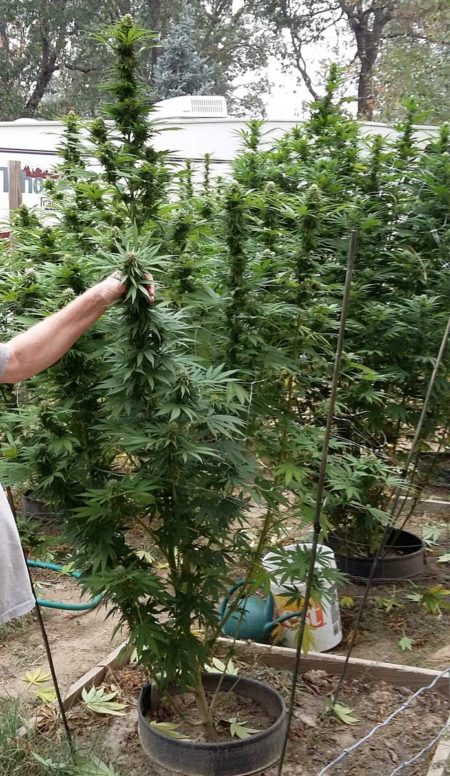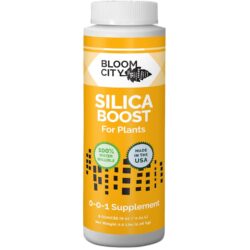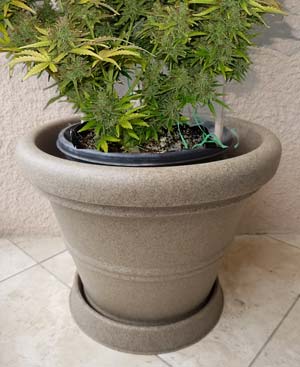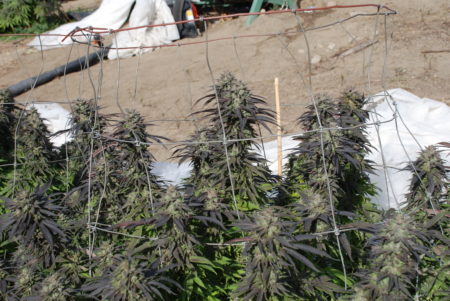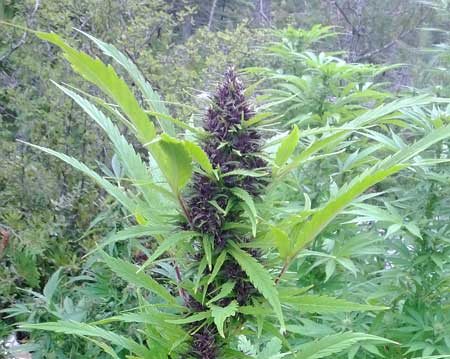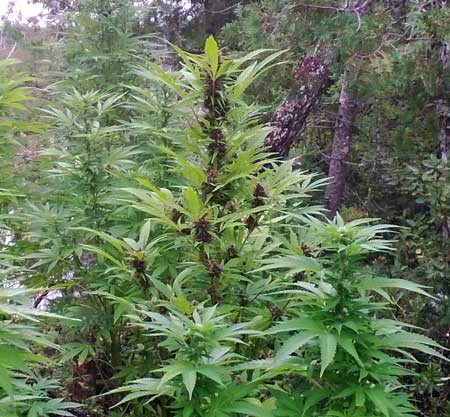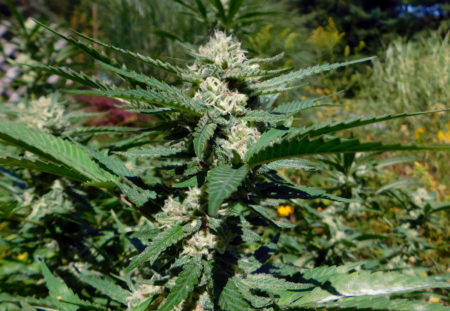by Nebula Haze
Outdoor cannabis cultivation is awesome. Free sunlight, no heat from grow lights, no electricity needed, and plenty of space for cannabis plants to spread out. But there is a catch: lack of control over the environment. For example, when it comes to growing cannabis outdoors, you have fewer options to reduce heat during a heatwave compared to growing indoors. You have even fewer options when it comes to controlling humidity outside for your cannabis plants. However, you are able to monitor your local weather via forecasts, and you can use that knowledge to help you prepare for whatever conditions are coming. It can often take a few weeks for plants to recover after a hot or dry spell, so prevention is the best medicine for outdoor marijuana plants.
It is possible to partially shield your plants when you know the temperature is going to get hot. You can also adjust your watering schedule to make sure plants at least have plenty of water.
Some things to try when you know the weather outside is going to be hot or dry:
- water plants in the evening or early morning to help prevent water evaporation during the hottest hours
- kelp extract for roots – provide a small amount of liquid fertilizer that contains seaweed kelp extract (can help protect against heat stress)
- silica supplements – silica (listed as Potassium silicate on the bottle) helps make plants more resistant to heat. However, it’s not a spot treatment. You need to be giving it to a cannabis plant as it’s growing so it can incorporate the silica into its cell walls. Examples: General Hydroponics Armor Si, Botanicare Silica Blast, and Dyna-Gro Pro-Tekt. Silica supplements tend to increase the pH of your water/soil, so they are extra awesome if you’re dealing with low pH or acidic soil
- increase shade to reduce the heat experienced by plants – you can use an old sheet or other cloth as a short term solution, or get a professionally made Sun Shade Sail which is made particularly to create shade outdoors. It’s important to remember that giving plants shade for more than a few days will make them less “hardened” to the sun, and you may need to reintroduce full sunlight back slowly to prevent them from getting shocked from high light intensity
- move potted plants – luckily with potted plants, it’s usually easier to move them out of direct sunlight during a heat wave
- put plant container inside a bigger pot – if a plant’s roots are kept cool, it can withstand much higher temperatures. If your plant pot is in direct sunlight, the roots are getting cooked during the day. If you put the pot inside a bigger pot, it creates air space around the roots and helps keep roots cooler. This is also part of why plants with their roots in the ground are able to better withstand heat.
- take extra good care of heat-stressed plants – when cannabis plants appear heat-stressed, try to baby them as best you can 🙂
Kelp extract helps plants withstand heat
Silica supplements like Silica Boost by Bloom City also help make plants more heat-resistant, especially when used consistently from when cannabis plants are young.
Put your cannabis plant container pot in a bigger pot to help keep roots cool outside.
Here are some strains that are heat-resistant and suitable to being grown outdoors:
Blue Venom – A G13 Labs strain that is resistant to heat, mold, and other stressors. Produces beautiful bud quality. A cross between two legendary heat-resistant strains, Blue Dream and White Widow. Get the best of both in one!
Frisian Dew – A popular strain because about half of the plants grow buds that turn an incredible, vibrant purple (the other half of plants grow green buds but still beautiful and the effects are just as good). This strain tends to grow the highest percentage of purple buds if plants in the flowering stage are exposed to very sunny weather with many hours of direct sunlight each day, as well as if plants also get cool temperatures at night. This strain is very well suited to outdoor growing, even in northern climates, and is especially resistant to mold.
The plant in the middle with the dark purple buds is Frisian Dew
Durban Poison – This African strain can stand the heat. I like Durban Poison because it produces strong but somewhat unique effects. They tend to be a medium size plant through they can get out of control if you let it stay in the vegetative stage too long. Quick to finish flowering, which is perfect to make sure your harvest comes in before it gets cold and rainy.
Super Lemon Haze – Does best outdoors and plants can get huge with big yields. Can handle the heat, though is less resistant to cold. Citrus smell and captivating effects.
White Widow – Incorporates African and Sativa genetics which help this strain deal with heat. Note: This is a VERY potent version of White Widow. Don’t plan to do anything later. This strain has been developed in the US to capture the effects of the original but in a much higher-THC version.
If you are growing cannabis plants outdoors, you should also be watching your local weather forecast so you can prepare when humidity is going to be too high. During humid conditions, it’s important to remove wind breaks that may be blocking wind from hitting your plants, which will increase airflow around the plants. By making sure plants are getting lots of fresh, moving air, you can combat mold and other problems normally associated with too-humid air.
Avoid over-watering plants during very humid conditions, and try to avoid allowing leaves to touch each other. Cannabis plants lose moisture through their leaves, and two leaves laying on top of each other during humid weather creates a humid environment for mold to take hold. Some light defoliation (removing leaves) may be needed to help prevent leafy outdoor plants from laying all over each other when it’s too humid, possibly creating the right conditions for mold to grow on the leaves or buds.
Keeping outdoor cannabis plants in pots or other moveable containers can be very beneficial when growing outdoors if you live close enough to your grow spot, because it gives you better ability to move the plants if needed to react to weather conditions. When your plant is in the soil, there’s very little you can do in bad weather besides wait and hope!
What about autoflowering strains?
Most auto-flowering strains are ready to harvest 2-3 months from germination, regardless of the sun’s light schedules. This can be helpful for growers in parts of the world that get several months of good weather in summer yet turns rainy or humid early in the fall before most photoperiod plants are ready to harvest. If you know that you’ve got at least 3 months of good weather, you can put auto-flowering plants outside and know they’ll be ready to harvest before the weather gets bad.
However, most auto-flowering strains start to struggle when it gets really hot. Their Ruderalis hemp ancestors originated near the Arctic circle in northern Siberia, and were much better suited to cold than hot. However, here are two auto-flowering strains that still do well in the heat.
- Amnesia Kush Auto – Gets a bit tall, but usually not too bad since it’s an autoflowering strain. Excellent “day” buds with a pleasant mental buzz.
- Zkittles Auto – I’ve grown this one in very hot temperatures and it didn’t seem to mind at all. Quick to harvest, easy to grow, and a smooth happy euphoria.
Learn about outdoor pest management
More tips on preventing outdoor heat stress

